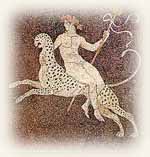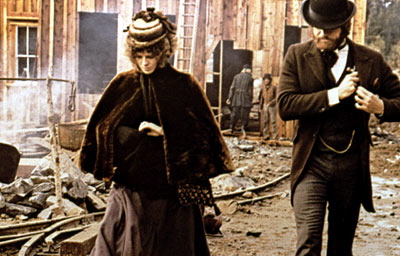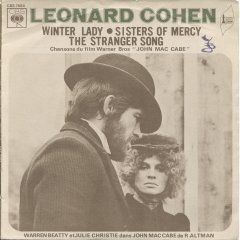The Grapevine Art & Soul Salon

Views and Reviews: Jonathan Knott

Looking at the Old West with Robert Altman in McCabe and Mrs. Miller, 1971: Matters of Style
McCabe and Mrs. Miller, a Robert Altman film starring Warren Beatty and Julie Christie. Cinematographer Vilmos Zsigmond. A revisionist Western set during the early 20th century, hailed as one of the top ten motion pictures of the 1970s and one of the best "Westerns" of all times, the film follows John McCabe, a drifter with a past, into a small Pacific Northwest mining town called Presbyterian Church, where he builds a makeshift brothel and casino with the help of an opium-smoking madam.
I never knew an actor in my lifetime or anybody's lifetime who didn't want to do a Western. We all want to do Westerns and believe me it belongs to us in this country, uniquely to us.... The Western is here to stay. Robert Duvall
If someone were to come in off the street and ask me to recommend a Western movie, I wouldn't think of McCabe and Mrs. Miller, though, in my opinion, it's a near perfect representation of what a Western should be. To treat it as a genre film doesn't do it justice. I value realism in film, and if the West was really all about winning high-stakes poker games in spotless mahogany saloons while wearing perfect form-fitting leather outfits with well-oiled Colts in place and throngs of disease-free whores that all look like Scarlett Johannson clawing each other's eyes out to give a freebie, I expect that's where most folks would still be living, instead of continuing on to California or coming back East. I think Robert Altman had a different vision of what the West was like, and I'd be willing to bet it's more accurate than most.
I like the fact that McCabe and Mrs. Miller appears to be set in the Pacific Northwest, for example (most other Westerns are set in the middle of a dusty prairie or cattle town), which makes for some fantastic natural backdrop for camerawork. The film seems to be as much about the land as anything else; there are lots of wide-angle shots of the trees, and almost every scene outdoors involves rain, mud or snow The land is cruel, it seems to say, or careless anyway. When it's not raining or snowing, the sky is almost always bleak, as if the sun just won't shine in this place. Everyone who's outside seems focused on getting where they're going--mainly, just inside somewhere. Most of the contrast in the film concerns the shelter of the indoors versus the harshness of the outdoors.
This contrast is achieved with colors as well. When I first saw the film many years ago on VHS (and yes, it's out on widescreen DVD now), I thought it was a drab film. Of course, I didn't know then what I was looking for, and an old VHS formated to a 19" TV lacks the detail visible in a DVD on a 50" screen. The indoor shots are almost entirely shades of brown. It sounds drab, but it really isn't. So much is done with the lighting: characters are always lighting matches or kerosene lanterns, making the dark gradually recede or disappear altogether and changing the nature of the static brown surroundings by illuminating them with different degrees of reddish-brown flame. Normal faces and expressions appear more interesting when they're suddenly illuminated by the instant crackle of an open flame or the gradual warm glow of a lantern. Light brings out the eagerness in people's eyes.
It looks to me as if the cinematographer is using different kinds of film; the indoor shots are soft and slightly blurry, while the outdoor shots are always crisp and clear (except when it's raining), and the muted reddish browns of inside are replaced with the harsher brown of the muddy road and the brilliant white of the snow or the crisp green of the trees. The costumes are also matched to the mood, with lots of olive, charcoal, and various shades of brown/red brown (especially on the women), all colors that are either enhanced by the indoor lighting or subdued to match the outdoor harshness.
The film has no traditional narrator. The "narration" is divided between the camera and the soundtrack. In earlier viewings, I considered the film to be slow-paced (it seems longer than its actual two hours), so this time I checked the speed of the scenes. The pace is actually not particularly slow; it is in fact quite fast in some places. I think the feeling of slow pace comes from the wide outdoor shots (which include seasonal changes from cold, rainy and shitty to colder, rainier and shittier) and the way people move when they are bent under the weather, as if to a purpose only a certain pace will let them achieve.
The pace is also determined by the excellent soundtrack, which is made up entirely of three Leonard Cohen songs. "The Stranger Song" is the one used at the very beginning to establish tone for the film, and variations of it are played throughout in scenes involving Warren Beatty. "Sisters of Mercy" debuts with the arrival of the whores and is similarly used at later times. "Winter Lady" comes when the final snow sets in and things turn tragic. That the gentle Spanish guitar and haunting sound of Cohen's voice match this film perfectly instead of stealing it is a testament to the overall quality of the film. The lyrics are so perfectly aligned with what you see happening on screen, it's hard to believe the music was actually written about five years earlier. After the wrap of McCabe and Mrs. Miller, Altman began to remember Cohen's music from earlier listening and inserted the songs during post-production.
Other than when these songs are playing, there is no music, only sounds like the splattering of rain or howling of wind. Great attention is paid to sounds when the camera is focused indoors. Early on, when the building structures are still rudimentary, there's much sound of wind and rain, and people indoors are obviously glad to be inside, though they are not comfortable. Later, as the town grows more prosperous, there is more contrast between indoors and out, and the howling wind is replaced by music boxes and the laughter of women. The light becomes brighter (though still reddish brown) and the film is a bit softer, with a warm, slightly smoky haze. One constant remains throughout, though: there are lots of overlapping conversations, and no words are wasted. People whisper in the background, and you can hear what they're saying. One thing I find curious is that with all the attention paid to both music and general sound, this film was recorded in mono. I wonder if that helps make background voices clearer to come through all speakers.
I noticed that there are lots of shots of people's legs and feet, whether they're walking through the mud or snow or across the little bridge into town, standing by a gravesite or dancing on the ice. It feels to me as if Altman and his cinematographer are trying to connect everyone to nature, to remind them that they're grounded and at the mercy of the cruel climate they've brought themselves to and the limitations of living there. Obviously, they're adventurous, or they'd never have come, but they're also desperate for love and warmth. They seem capable only of a certain unsatisfying degree of either (which I suppose comes from everyone preying on everyone else, businesswise). Displaying this mood realistically can't be done with camera and music alone.
The acting is uniformly excellent. Warren Beatty is by all accounts an ass, but no matter how many times I watch this film, he ceases to be himself after a minute or so and becomes the completely compelling McCabe. He doesn't hold the monopoly on being perfectly cast, however; even people in this movie that I remember as always having had "bit parts" in other ones seem somehow to be perfect here.
One scene that particularly brings out the yearning of these people for some kind of comfort involves two couples (miners and whores) who are dancing around what appears to be a very early music/juke box. When the music stops, they gather around the box and stare like little children while the mechanism switches in silence to a different tune. When it starts playing, they begin again their excited dancing. For us as for them, these little joys last only a little while, as Altman, at the end, brings us back down to earth with a particularly nasty gunfight in the snow.
During the final long, tense sequence, the camera makes use of wide shots of the town covered in snow, of silence but for the crunching of boots, followed by bursts of violence set against raw wood backgrounds, as McCabe darts from empty building to empty building, trying to survive. The camera watches him leave a burning church (where he was thrown out by a preacher shouting, "This is a house of God!") and make his way to a saloon labeled "House of Fortune" on the front. McCabe slips behind the bar, already gut-shot, and gulps down his typical meal of raw egg in whiskey, only this time it's two eggs in four shots (raising the stakes?). Altman's realistic world unfolds at a quick pace. As McCabe finally dies in the snow, the camera takes us to his lady love laid out in an opium den, smoking away her awareness of what is happening to him as she stares at a bright, pretty object. The camera moves into her dilated pupil, and we then see the bauble up close, turning round and round.
McCabe an Mrs. Miller is a truly original film, created out of what is perhaps the most cliched genre of our time, the Western. Altman's unrelenting attention to characters in a naturalistic setting moves the film from realism into naturalism and stamps it with his unique style of storytelling. In Altman's vision, the land claims the people, and the cycle goes on, brutal but objective, much like Nature itself.


E-mail Jonathan: jknott@grapevineartandsoulsalon.com
Copyright ©2008 Barbara Knott. All Rights Reserved.
Contact the Webmaster.